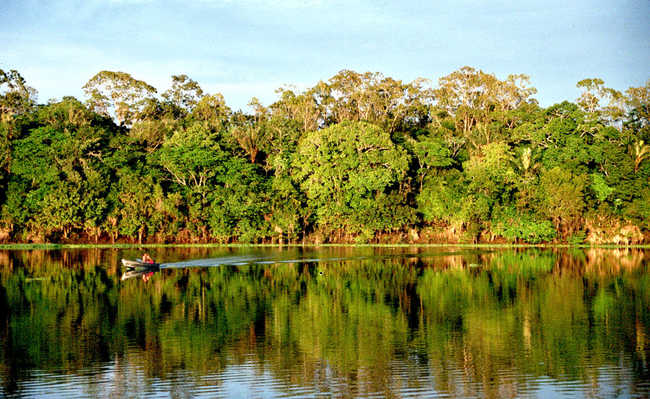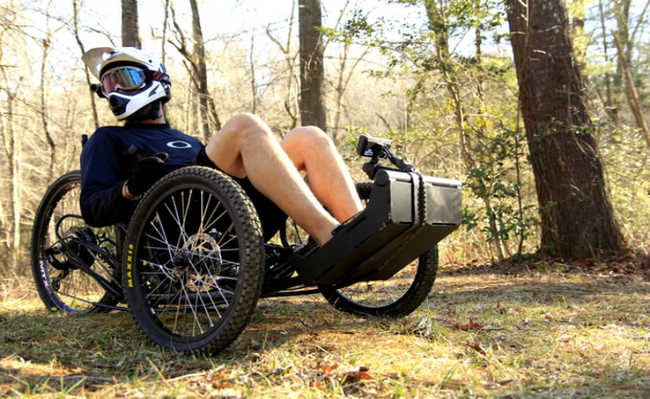Meet Atafona, one of the first victims of marine erosion in Brazil
In this former resort on the coast of Rio de Janeiro, the Atlantic has been destroying streets, houses and businesses for over 50 years. It is estimated that the waters have already brought down at least 500 buildings

Atafona Beach, in RJ. Image: Mongabay
Victims of a slow and continuous environmental impact that has been destroying the coast, the residents of the district of Atafona, in São João da Barra (RJ), seek to reframe their relations with the city while living the expectation of an uncertain future. With the sea swallowing their homes for over 50 years, they are waiting for solutions to the impacts generated in the community where one of the most severe environmental disasters of marine erosion in Brazil occurs.
Specialists point out as causes of this phenomenon a sum of factors, which include human actions and the effects of climate change in a region that, since the beginning, had a disorderly housing occupation along its coast.
The first known records of coastal erosion in Atafona date back to 1954, on Ilha da Convivência, which today has been practically swallowed up and its inhabitants forced to leave their homes and seek housing elsewhere.
On Atafona beach, the event took place about five years later, but the destruction intensified in the 1970s and has not stopped until today. The City of São João da Barra estimates that the advance of the sea has already destroyed 500 homes and businesses. Local residents and researchers estimate that this number could be even higher and that the number of people forced to move, including migrating to other cities or states, has exceeded 2,000.
Sônia Ferreira, a resident of Atafona for over two decades, saw the sea gradually approaching until the wall of her house was knocked down in March 2019, a decisive fact for her to decide to take action after years of waiting. “Last year, the sea reached my street and knocked down my wall. I had to put up fences because I want to continue living here for a while longer. I'm already demobilizing the house and moved to a little house I built in the back. That way I can stay here on my land for a few more years until the sea takes up everything for good”, he says.
Worldwide, the number of people displaced by environmental causes — such as coastal erosion, forest fires, floods and landslides — outstrips the number of internal conflicts. According to the International Organization for Migration (IOM), a total of 295,000 new displacements due to environmental disasters were registered in 2019 in Brazil.
The data, however, only account for disasters occurring in specific events, such as floods, landslides and storms. But not in more gradual processes like Atafona's. Last year, according to data from the IDMC (Internal Displacement Monitoring Center) report, the country counted 240 people forced to move in Brazil due to coastal erosion, but the IOM believes that there is underreporting.
why the sea advances
One of the main causes pointed out by the impact in Atafona is the decrease in the flow of water from the Paraíba do Sul River and its consequent siltation, caused by the construction of upstream dams. This makes the Atlantic win the arm wrestling match with the river at the mouth, with effects on the flow of currents, the accumulation of sand and mud in the bed and the movement of waves on the beach.
The deforestation of riparian forests along the entire river course would also have contributed to the siltation of Paraíba do Sul, as well as the population increase in the surrounding cities, which supply themselves with the same water — such as Campos dos Goytacazes, with half a million inhabitants , located just 40 km from Atafona
Natural geological processes are also pointed out as one of the factors, at a very slow pace, but there is a consensus among researchers and residents that coastal erosion has been intensified and accelerated as a result of a combination of human actions and the effects of changes climate, such as sea level rise.
According to Gilberto Pessanha Ribeiro, cartographic engineer, professor at the Instituto do Mar and coordinator of the Coastal Dynamics Observatory at Unifesp, who has been researching the case of Atafona for 17 years, there must be more people studying the subject. “We made fantastic discoveries about the diversity of understanding of the phenomenon in the community. Even anthropological questions arose. It is an area of the coast that mixes science, affection, mysticism and religion. People love that place. There is a lot of affection involved. Atafona became a character”, highlights the researcher.
“People want categorical answers, but it is too complex a topic to have a simple answer with definitive alternatives”, continues Pessanha Ribeiro. “The cause is a combination of factors. And the solutions also need to be multiple. Today, we see a movement not for a definitive solution, but for coexistence with the issue and for scientific learning to educate the population and develop knowledge in the area.”
Recently, the channel in the southern part of the mouth was closed by the siltation of the river, further aggravating the crisis of local artisanal fishing and putting the survival of the region's traditional community at risk.
As much as the phenomenon has been happening for over half a century, it is still a case relatively little known by public opinion in general, given its relevance. The local population analyzes that the actions of all spheres of government throughout history have been shy. Currently, residents are putting pressure on governments and institutions involved in the hope that action will be taken, even though there is no obvious or quick solution to the problem in the short or medium term.
Climate change accelerates erosion
In 2016, when I started researching the production of the documentary Advancing, in the production phase, I spent a few days in Atafona with a local team to record the situation at that moment and return years later to complete the film. The images in photo and video that illustrate this report were produced on that occasion, revealing some buildings, houses and places that no longer exist or that have changed in relation to what was documented at the time. These are scenes that symbolize the strength of the continuous degradation generated by the movement of the sea that advances about 3 meters a year.
For geographer Dieter Muehe, one of the country's leading specialists in coastal erosion, the advance of the sea in Brazil is not just a reality, but a trend. “Atafona is a hot spot of continued trend. The beach gains and loses sediment, but the balance in Atafona is not balanced. The beach near the mouth loses more than it gains, which causes erosion”, he explains. “And the mud also prevents the mobilization of the seabed. The river does not throw the amount of sand it should into the sea. With the dams, there are no more exceptional floods that expel large amounts of sand onto the platform. Climate change accelerates the erosive process, as it influences the frequency and intensity of more extreme storms and hangovers.”
The most noticeable effects of coastal erosion for the Brazilian population, according to him, are those that occur in urban areas, due to the material damage it causes. “The advance of the sea is, yes, a trend. The sandy barrier had been slowly approaching the continent for centuries in an imperceptible way. We observe that today the effects of human actions on the environment are accelerating this process. What can be seen is that the process is so fast that a human being can perceive it throughout a lifetime. A person who lives in a more vulnerable area on the coast may even manage to spend a lifetime in that dwelling, but it may not last for generations to come”, says the geographer.
This was the case of local journalist João Noronha, who in 2006 lost to the sea the house he inherited from his family. Author of two books on Atafona, he has the third ready to be printed. “In the 1940s, Atafona became known for being a medicinal beach. In the 1970s, it became fashionable and staged dances for the aristocracy of Rio de Janeiro in big clubs”, he says. “Initially, I was reluctant to bring up the subject of erosion in the newspapers I wrote for. He had a certain blockage due to the sentimental value of someone who went through the trauma of losing his family's home. Weeks before my house fell, I donated all the materials that were in it and moved to another one, much smaller, in another neighborhood 6 km away. The municipality should not have allowed construction in the coastal area.”
Possible solutions

Atafona Beach, in RJ. Image: Mongabay
The mayor of São João da Barra, Carla Machado, observes that two phenomena occur simultaneously and believes that they are interconnected. In addition to the advance of the sea, which has already destroyed many blocks, dunes are in full formation. They grow and move with northeasterly winds and already affect houses. Today, they are already approaching Grussaí beach, which until then had been little reached. “I'm in love with Atafona. It was part of my youth. Those who live there have a very strong bond with the region. But culturally people don't want to leave. We have already built popular houses, but no housing plan meets their expectations”, he says.
According to the mayor, there is no consensus on the solution to the problem. Recently, there was a meeting of the City of São João da Barra with members of institutions involved in the issue — such as the Federal Public Ministry, the Fluminense Federal University (UFF) and the National Institute of Waterway Research (INPH) — to discuss possible projects. But there is still no definition of what will be implemented, when and by whom it will be financed.
Among the ideas presented, there are two proposals to build barriers and another to increase the beach strip. But there are no guarantees of the efficiency of the initiatives. “There is no simple solution. As it would require serious intervention, there are disagreements in the development of these projects. There are several pre-projects that still need technical studies and large investments, in addition to the approval of the competent bodies for their regulation. There is also a lack of resources and the municipality cannot afford these investments alone”, explains the mayor.
According to the Environment Secretary of São João da Barra), Marcela Toledo, nowadays the most traditional communities are suffering from the greatest impact: “At the beginning of the advance of the sea, most of the affected buildings were from high society Campos dos Goytacazes, which had summer residences, in addition to several buildings of commercial points, clubs, among others”.
Toledo explains that, today, the affected homes belong to traditional families linked to fishing activities, including shellfish gatherers. In March 2019, the last great advance of the sea on the houses, three families were removed, a total of seven people, who are being assisted by the Municipal Program for Eventual Benefit in Social Rent. In total, 35 people from 14 families are currently being assisted by the program”, reports the secretary.
memory and self-esteem
The recent history of Atafona began to directly influence the way its inhabitants see life, their territory and the world, in a continuous process of transformation and adaptation. An artistic initiative has been helping in the last three years to develop the self-esteem and memory of the Atafona community, with a project that aims to help stimulate the creation of new meanings for the relationship between the local population and the ruins. Casa Duna — Atafona Center for Art, Research and Memory, offers artistic residencies, performs cultural productions, events and plays.
When it opened its doors in 2017, Casa Duna also held exhibitions with the historical collection acquired by the creators of the local poet Jair Vieira, who until then had a small gallery of photographs, books, maps and reports on Atafona in his house.
According to Julia Naidin, Ph.D. in philosophy and co-founder of Casa Duna, the project's idea is to help the population using art to shed light on the environmental issue and to generate new regional narratives. “We want to work against the stigma of the ghost town, a label that bothers residents who live well in the city and have a strong emotional bond with it,” she says. “Art guides and sensitizes without generating ready speeches. It helps to provoke reflection, broadens perception and multiplies debate. It is necessary to remember that there is life, territorial bond and resistance.”










